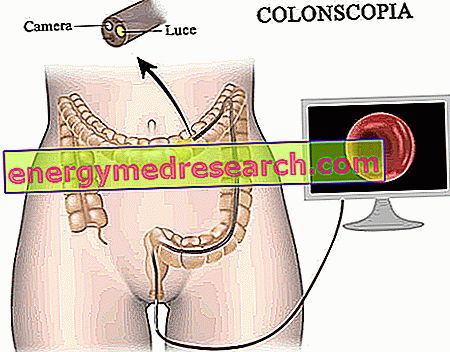Generality
The broken tongue is a condition characterized by the presence of cuts and fissures, more or less deep, on the back and / or on the lingual margins.

Also known as a scrotal or plicata tongue, this manifestation does not necessarily have a pathological meaning (for example, when it is hereditary or secondary to aging). Sometimes, however, cuts on the tongue are part of the symptomatology of some diseases localized in the oral cavity or systemic (eg traumatisms, infections, autoimmune diseases, neurological pathologies, allergies and pharmacological therapies).
Depending on the cause, the broken tongue can be associated with other symptoms, including pain, halitosis, taste changes, tingling and burning.
In some cases, cuts on the tongue tend to resolve spontaneously within a few days, but it is possible to resort to some remedies to speed up and promote healing. Other times, instead, therapeutic interventions aimed at solving the underlying pathology are necessary. In general, good oral hygiene helps prevent the complications associated with the broken tongue.
What's this
What is Split Language?
The broken tongue is a condition of a generally benign nature, characterized by the appearance of fissures, grooves, cracks or cuts on the back and / or sides of the tongue. These signs may be more or less pronounced and, on some occasions, may be associated with other disorders, such as tenderness, hypersensitivity and burning.
Why is it called Scrotal Language?
The curious name of the " scrotal tongue " derives from the fact that the appearance of the wrinkled tongue vaguely resembles that of the scrotum.
Other terms used to indicate the split language are:
- Cracked tongue ;
- Plicated language .
Causes and Risk Factors
Split Language: what is it caused by?
The split language is a rather specific manifestation, although the causes can be manifold . For example, the appearance of cuts may indicate marked dehydration, an iron deficiency or oral thrush infection; at other times, the scrotal language could signal a more severe problem, as in the case of autoimmune diseases or poorly controlled diabetes.
It should be noted that the fissured tongue does not always result from pathological causes . The cuts on the tongue may depend, for example, on a genetic predisposition ; other times, it is the normal aging process that makes the naturally present furrows on the tongue more pronounced.
Note
In some people, the broken tongue can be a genetically inherited condition, therefore present, in a more or less evident way, from birth. Some scientific research suggests that this characteristic may represent, in fact, a polygenic or autosomal dominant trait, with incomplete penetrance.
What diseases are associated with the broken tongue?
Many of the possible pathologies responsible for lingual cracks can be recognized, fortunately, for distinctive signs and symptoms.
The main diseases related to the appearance of cuts on the tongue are:
- Map language (or migrant erythema)
Normally, the tongue is covered by a series of papillae, that is, small white-pinkish bumps.
The language on a map is an alteration that radically modifies the lingual surface, causing the appearance of several red, smooth and papilla-free patches that join together, making it similar to a map.

The papillae reform in one area, then fail in another, giving the illusion that these patches move over time; for this reason, the pathology is also known as migrant erythema. The smooth areas make the natural fissures more evident in the broken tongue.
The language on a map is due to causes not yet known, but sometimes it is accompanied by other inflammations of the organism (eg infectious diseases).
The absence of the papillae can make these areas more susceptible to irritation by eating certain foods.
- Iron deficiency or vitamins
Furthermore, when the tongue splits and is more reddened than usual, it is possible that at the origin there are nutritional deficiencies, especially minerals (iron or zinc) and vitamins (B1, B2, B6, B12, folic acid and niacin) . This situation is found, for example, during therapies with antibiotics, which alter the intestinal bacterial flora and can make it difficult to absorb nutrients.
In particular, if iron and vitamin B12 (biotin) are deficient, they can develop on the tongue of wide and smooth patches, which will make the natural fissures in the tongue more evident.
The main local factors that predispose to burning in the tongue are irritation, chronic trauma and lesions involving the mucous membrane of the oral cavity.
Other causes and predisposing factors
With regard to the possible causes of the split language we must mention:
- Infections of the mucous membranes of the oral cavity, such as candidiasis ( Candida albicans infection): the so-called oral thrush can lead to the development of cracks on the lingual surface, besides causing pain, whitish lesions and alterations of the sense of taste. Candidiasis occurs mainly in people with an already compromised immune system, in children and the elderly.
- Nigra villosa tongue : this benign and self-limiting oral condition makes the lingual mucosa greenish or dark brown, with filaments that resemble hairs. In this context, the filiform papillae are abnormally hypertrophic and elongated on the surface of the tongue, therefore they tend to trap food residues and microorganisms. This condition favors the infection of a fungus, Aspergillus niger, which can develop when the oral bacterial flora is altered. Factors that favor the villosa nigra language are:
- Prolonged use of local antiseptics or broad-spectrum antibiotics;
- The poor salivation;
- Chronic dryness of the mouth (xerostomia);
- Unsatisfactory oral hygiene;
- The states of immunodeficiency.
- Tongue cancer : the fissured tongue - in combination with other manifestations, such as pain and swelling within the same cuts - may be the indicator of a tumor process. Usually, a persistent nodule (or another lesion that does not show any signs of regression) is among the first symptoms to begin. If it is suspected that an injury on the broken tongue is not caused by an ulcer or other benign condition, it is essential to consult a doctor.
Other causes of the broken language are:
- Melkersson-Rosenthal syndrome (rare neurological disorder);
- Cowden syndrome (rare hereditary disease);
- Down syndrome (genetic disease in which chromosome 21 is a supernumerary);
- Sjögren syndrome (autoimmune disease);
- Traumas (continuous and repeated irritations caused by incongruous dental prostheses, pointed teeth or orthodontic appliances, etc.);
- Bruxism (teeth grinding during the night);
- Excessive consumption of alcohol and chewing tobacco ;
- Dehydration .
The conditions associated with the split language may also include:
- Allergic reactions (food or to materials used in dentistry or products for oral hygiene, such as toothpaste and mouthwashes);
- Chronic granulomatous disease;
- Pustular psoriasis;
- Scarlet fever and other exanthematous diseases, such as measles and rubella;
- Immunodeficiency (in particular, from HIV).
- Malabsorption syndromes;
- Side effect of some drugs and radiation therapy;
- Poorly controlled diabetes.
Symptoms and Complications
Split Tongue: what does it look like?
A broken tongue is recognized by the presence of cuts, cracks and furrows, more or less deep and variously arranged, on the back and / or at the lingual margins .
Cracks can be associated with tenderness, taste changes, halitosis and dry mouth . The broken tongue can also be completely asymptomatic, ie it does not cause particular discomforts, except for the obvious presence of cuts. As for the characteristics of the latter, it should be noted that the distribution can be more or less generalized, that is it can affect only one or most of the lingual mucosa.
Generally, cracks are present only on the tongue and do not involve other parts of the mouth.

Appearance and characteristics
- In most cases, the split tongue manifests itself with an evident fissure that runs along the center of the surface of the lingual mucosa; from this pronounced sign divide smaller cuts . Other times, the cracks are evident above all on the edges of the tongue.
- The cracks of the broken tongue can be superficial or extend in depth for some millimeters.
- The broken tongue can affect the perception of tactile, thermal and gustatory sensations, altering them. It is possible, for example, to feel burning or pain when taking particularly salty, too hot, spicy, acidic or spicy foods.
- The broken tongue may be red or appear white or yellow .
Signs and symptoms associated with the Scrotal Language
In addition to the obvious presence of cuts and cracks, the broken tongue can be associated with other manifestations, such as:
- Tongue pain;
- Tingling or numbness of one or more areas of the tongue;
- "Needle puncture" sensation (similar to a pricking sensation),
- Burning of the tongue (glossopirosis);
- Hypersensitivity or aggravation of symptoms when taking certain acidic, salty or spicy foods;
- Bitter or metallic taste;
- Dry mouth (xerostomia);
- Increased thirst;
- Lumps or lesions on the tongue or near the mouth;
- Bad breath;
- Sensation of having the tongue more swollen than usual;
- Swelling in other areas of the face or mouth;
- Muscle weakness.
Possible complications of split tongue
The broken tongue is a benign condition, therefore harmless in almost all cases.
However, food particles and debris can build up in deep cracks that promote bacterial and fungal proliferation. If oral hygiene is neglected, this phenomenon actually increases the risks of incurring inflammatory diseases of various types, infections and odontostomatological problems (caries, tartar, etc.). Plaque stagnation inside the fissures can cause tongue burns.

From the colonization of cuts on the tongue other problems can arise, such as:
- Halitosis (bad-smelling breath);
- Glossitis (inflammation of the tongue).
In glossitis, in particular, the lingual mucosa appears red, with fringed edges, and on the surface the impressions of the teeth remain impressed. In addition to redness and swelling of the tongue, inflammation typically also causes burning, pain, thickening or atrophy of the taste buds, dryness and flaking.
Diagnosis
Split Language: how is it diagnosed?
Given the wide spectrum of possible causes, the characteristics of the broken tongue and the onset of this disorder in relation to other symptoms are important for the differential diagnosis.
In this regard, to detect the concomitant manifestations of the scrotal tongue, a visual inspection of the oral cavity is provided, including observation of furrows and cuts. The evaluation is completed by the patient 's medical history .
During the diagnostic procedure, it is also important to ascertain any ongoing pharmacological therapies that may have altered the oral microenvironment (as in the case, for example, of antibiotic, antihypertensive and antihistamine therapies).
If the cause is not immediately obvious and there is reason to suspect an underlying condition, it is possible that other clinical and laboratory investigations, such as:
- Blood analysis to ascertain any haematochemical alterations and identify any nutritional deficiencies:
- Blood count with leukocyte formula;
- Glycemia;
- Glycosylated hemoglobin;
- Azotemia:
- VES;
- Sideremia, ferritin and transferrin saturation index;
- transaminases;
- Thyroid Screening;
- Dosage of vitamin B12 and serum folate;
- Skin allergy tests (patch-test) for dental materials and probable food or other allergens;
- Oral mucosal buffer and culture microbiological examination for the detection of fungal and bacterial infections;
- Ultrasound of the salivary glands;
- Chemical examination of saliva;
- Biopsy of a small portion of the broken tongue or a specific lesion to determine if it is cancerous or benign.
Treatment and Remedies
Split Language: which treatment is expected?
There is no specific therapy for the broken tongue and most causes resolve on their own without treatment; otherwise, the doctor can establish a protocol to resolve or minimize the problem, prescribing drugs or other interventions depending on the diagnosed disease.
Melkersson-Rosenthal syndrome is treated, for example, using NSAIDs, while Sjögren's requires salivary substitutes and artificial tears. If an infection is detected, the use of antifungals or antibiotics may be indicated, while the reactivity to certain allergenic substances may be limited by antihistamines .
Remedies for Language Cuts
- Avoid irritants
A correct approach to the problem of cuts on the tongue consists in removing any aggravating or triggering factors at the local level, such as spicy foods and potentially irritating oral products (for example, opt for alcohol-free mouthwashes and toothpastes with flavor enhancers and flavorings). If the broken tongue depends on a chipped tooth, the habit of grinding teeth in sleep (bruxism) or a dental appliance, it is advisable to consult the dentist to evaluate possible solutions that can make these conditions less irritating.
- Attention to dental hygiene

The pronounced cuts of the broken tongue can represent the ideal environment for the proliferation and colonization by bacteria and other microorganisms. Therefore, a good habit is to wash your teeth regularly, paying particular attention to cleaning the tongue, using a toothbrush or a lingual scraper (also called tongue cleaner). This tool can be associated with typical oral hygiene products such as toothbrush, floss, pipe cleaner, mouthwash etc.
- Drink a lot of water
Dehydration is one of the potential causes of the broken tongue. To avoid that the cuts are emphasized, it is good to be careful to take an adequate quantity of liquids (water, herbal teas etc.) during the day.
- Other tips
To avoid that cuts on the tongue arise or become worse it is good:
- Adopt a balanced diet (making sure to take an adequate amount of biotin and iron with the diet if they are deficient);
- Avoid biting the tongue or using it against foods and sharp objects;
- Stop smoking and chewing tobacco;
- Abolish alcoholic beverages and reduce coffee or tea intake;
- Suspend pharmacological treatments that are not strictly necessary.
In any case, if the broken tongue is a cause of discomfort and pain or is associated with injuries that do not seem to resolve, it is advisable to consult your doctor, dentist or dermatologist.



